By Donald-Brian Johnson

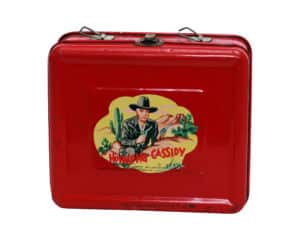
Blame it on Hoppy. When the Hopalong Cassidy tin lunchbox hit stores in 1950, bag lunches faced a formidable competitor. Now, those tasty peanut butter and jelly sandwiches could be packed securely in a container festooned with images of your favorite performers or TV characters. Even better, the accompanying thermos bottle, (ready to be filled with anything from chocolate milk to tomato soup), carried through the visual theme. Kids loved ‘em. In the first year of production, Aladdin Industries, Inc. (“Aladdin”), the Hopalong manufacturer, sold over 600,000 Hoppy lunchboxes, at $2.69 each. For the next 35-plus years (the “Golden Age of Lunchboxes”), metal lunchboxes provided a reliable source of bragging rights for schoolkids, a reliable tug on parents’ pocketbooks, and a reliable means of renewable income for the companies that churned out the boxes. After all, interests change. When Hoppy was no longer in fashion, there were the Marvel Super Heroes. Or Snoopy. Or all the stars of Star Trek. Or an entire busload of characters from the wonderful world of Disney. If you found your way to the top of the pop culture heap, chances were you would soon be immortalized on a lunchbox.
Working Up An Appetite
Mark Kelehan of Elkhorn, Nebraska, brought his lunches to school in a paper bag. Nowadays though, the avid collector has over 1200 lunchboxes in his collection, along with a massive assortment of related artifacts and reference materials. Here, in his own words, is how an enduring interest came to be:
“In 1994, I went to a flea market in Omaha and saw a 1980 Pac-Man lunchbox, and thought it was super cool, even though it was a little beat up. It reminded me of a lot of things from my childhood. After I bought that lunchbox, I was curious to know what others there were, so I found a lunchbox price guide. When I saw how many were actually made, it blew my mind and kick-started my interest in buying more. I would go to flea markets, antique malls, and garage sales, and just bought basically whatever I could that was within my geographic reach.
“When eBay arrived, it became much easier to find lunchboxes. During my time in New York, I started going to toy shows and meeting collectors who had other things like production art and production plates. That started me on this journey to go deeper than just the lunchboxes. The other things were more challenging and exciting, like finding former employees who had the artwork or finding collectors who bought prototype lunchboxes that were rare one-off things. I love hunting down this kind of stuff. It helped me better understand the companies and the history of lunchboxes. It’s exciting, and I meet new people along the way.”
One of those new people was Robert Jones, a former illustrator for Aladdin Industries, and many of its lunchboxes. Now included in Mark Kelehan’s collection: Jones’s original concept art for that 1980 Pac-Man lunchbox.
It’s Lunchtime!
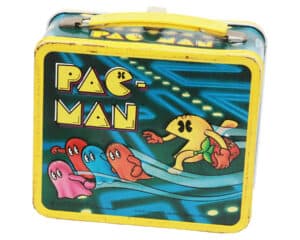
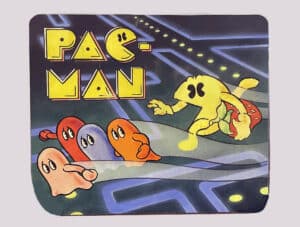
Long before metal lunchboxes added their rattle and clang to the sounds of a school day, kids (or in most cases, their moms), found other means of lugging those lunches around. At one time or another, folks relied on hollow gourds, wicker baskets, oilcloth wraps, or even oiled goat skins. In the 1880s, empty biscuit and tobacco tins were recycled as “lunch pails.” By the turn of the 20th century, metal lunchboxes specifically geared for children’s use were marketed. These early lunchboxes, on the order of kid-sized picnic baskets, featured generic illustrations of (what else?) kids. For most families, however, specifically designated lunchboxes were a luxury that bare-bones budgets could ill afford. The price: $3.50 each (over $100 in today’s money). So, in most cases, packed paper bags filled school lunchrooms.
Although Hopalong Cassidy was the first metal lunchbox to take the nation by storm, it wasn’t the first metal character box marketed. That distinction belongs to the “Mickey Mouse Lunch Kit,” which had limited production in 1935. Ads for the oval carrier proclaimed that it provided “ample room for sandwiches, fruit, cake, and pie, for even the most husky child with a big appetite.” After a short burst of interest though, World War II metal rationing meant that it was back to paper bags. Those with an appetite for any characters other than Mickey had to wait until the 1950s when Hoppy and his friends came thundering through with their bountiful buffet of appetizing options.
After Aladdin’s salute to Hopalong Cassidy, the next King of the Cowboys to saddle up was Roy Rogers. The Roy Rogers lunchbox came courtesy of Aladdin’s main competitor, King-Seeley Thermos (known today as Thermos L.L.C.). In 1953, King-Seeley sold 2-1/2 million Roy Rogers lunchboxes. The increased popularity can be traced to the vivid, full-color lithographed images on every side of the lunchbox, starring not only Roy but also his compatriots Dale Evans and Trigger. (The 1950 Hopalong Cassidy lunchbox was a single color, with a Hoppy decal on one side.) By 1954, seeing which way the market winds were gustily blowing, Aladdin had also switched to fully-illustrated, full-color lunchboxes, and Hoppy was upgraded. (A later Aladdin innovation: “embossed” designs, first appearing in the early 1960s, adding a three-dimensional aspect to the illustrations.)
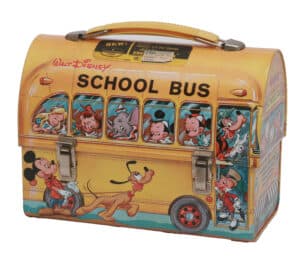
10 million of this design by Robert Burton were sold in the 1960s.
What popular figures appeared on which lunchboxes were dependent on licensing, and Aladdin Industries and King-Seeley Thermos duked it out for each major acquisition. Aladdin acquired the rights to such prizes as the Disney, Marvel, and Star Trek characters. King-Seeley captured such in-demand properties as Star Wars, Peanuts, and Hanna-Barbera favorites including The Flintstones. Among the other companies joining in with less prolific lunchbox output were ADCO Liberty, Okay Industries, Ohio Art, and Universal. From 1950 until 1986, over 200 million lunchboxes were sold. (The most popular: the “Disney School Bus” from the 1960s, with nearly 10 million purchased.) That’s a lot of peanut butter and jelly sandwiches.
So Where Did They All Go?
There are still some new metal lunchboxes on the market today, although these are intended for collectors, rather than kids-eating-lunch use. The phaseout of metal lunchboxes in the mid-1980s can be traced in part to parental fears (often unsupported) that the boxes were being used as weapons. A more likely explanation is that the preferred replacements, molded plastic lunchboxes, with all-plastic “thermos bottles,” were cheaper to produce. While less likely to bash in heads during a lunchroom rumble, plastic boxes offered little in the way of artistic appeal. And, as backpacks/book bags became the rampant carryalls for school supplies, even the plastic boxes began to vanish. Smaller and softer packaging that could be maneuvered into a backpack without squashing that sandwich became the norm. The last metal lunchboxes to be mass-produced were 1985’s Rambo from King-Seeley, and Aladdin’s Thundercats in 1986.
Fortunately for collectors, 120 million lunchboxes mean there are still plenty around to collect. A recent check on eBay brought up nearly 11,000 listings. Many, of course, are in less than pristine condition since they were used for daily not-so-delicate use and have been knocking around for at least 60 to 70 years. The selling price for a lunchbox in “average” condition can range from $50-70. A box with significant damage, unless it is historically important, will sell for much less. One with its original tags will sell for much more. For truly determined “paileontologists,” Holy Grails include the 1954 Superman lunchbox. In 2021, a mint lunchbox featuring the strange visitor from another planet realized $18,000 at auction. An analysis of eBay lunchbox sales for 2022 showed a total of over 29,000 sold, with receipts totaling almost 2 million dollars (which will buy an awful lot of peanut butter and jelly).
Thinking Outside The Box
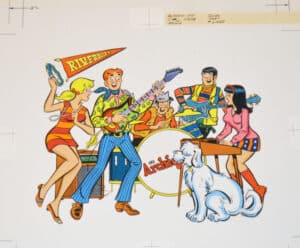
artwork (shown above) for Aladdin’s Archies lunchbox, 1969. (at right)
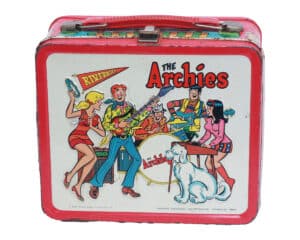
Kelehan’s exhibit, which he created with support from The Durham Museum, featured over 500 of his lunchboxes, as well as numerous examples of lunchbox art and production materials. In addition to detailing the history of lunchboxes, their major manufacturers, and their vibrant artwork, his writings for the exhibit cover primary factors in their development. Among them: marketing research, license acquisition, actual lunchbox production, and, of course, the world of lunchbox collecting, from its origins in 1979 up to the present day. Future goals, already in the works, include having the exhibit travel to other venues across the nation, plus one or more books on lunchboxes. Says Mark, “I think the topic and insights are timeless, and are a great reflection of history and popular culture in the United States. They all tell stories.”
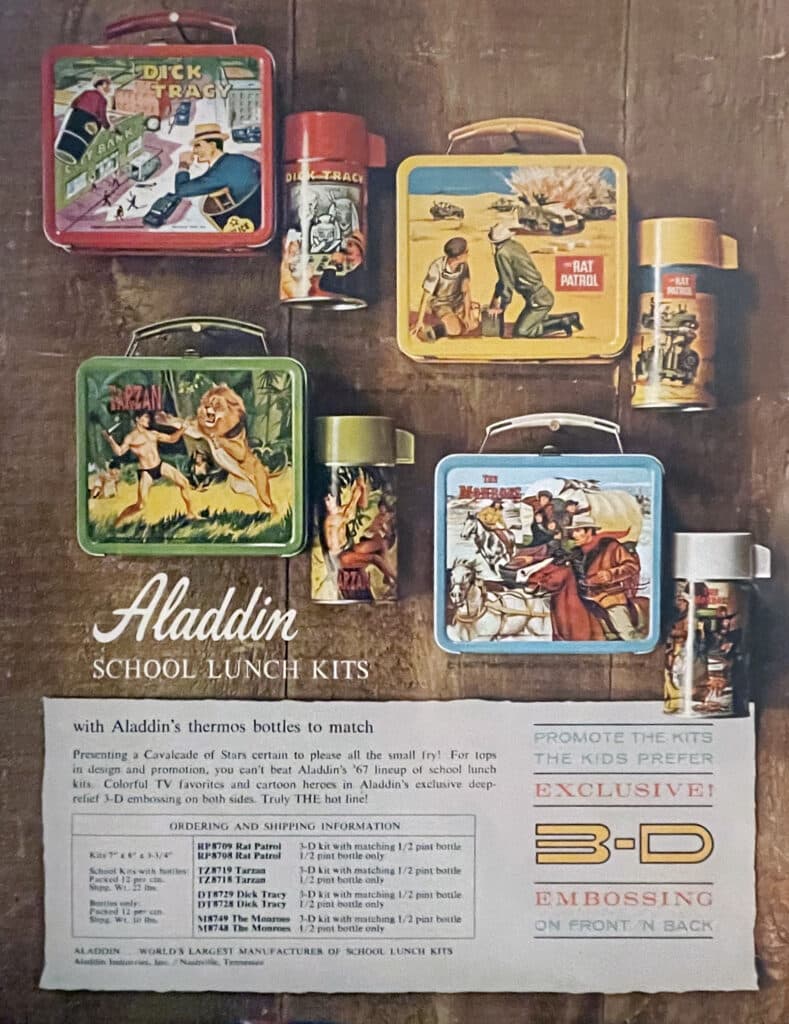
Judging by survey responses during the Omaha showing, those stories still resonate. Asked what they enjoyed most, similar phrases from attendees popped up with regularity: “the nostalgia”; “the history”; and (here’s the most important one), “the fun!” That’s just the reaction Mark Kelehan was hoping for: “In my opinion, collecting anything, including vintage lunchboxes, should first and foremost be fun. If you can have fun and accomplish what you set out to do, you will get a great sense of self-satisfaction and accomplishment. Once you accomplish your initial goal, you can display them for you and others to enjoy, and call it a day. Or, if you’re like me, you set new goals, and then progress toward those. That statement applies not just to collecting, but to almost anything you want to accomplish in your life. Set aspirational goals, work hard with integrity to achieve them, don’t give up, and—most importantly—have fun!”
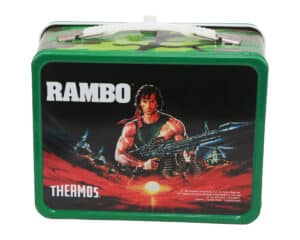
mass-produced by King-Seeley
Thermos, 1985.
Lunchboxes = History + Nostalgia + Fun!
Some things just kind of go together. Sort of like peanut butter and jelly.
All photos and reference materials courtesy of Mark Kelehan (mak.lunchbox@gmail.com)
Photo Associate: Hank Kuhlmann
Donald-Brian Johnson is the co-author of numerous books on design and collectibles, including Postwar Pop, a collection of his columns. He lived near his school, so he usually went home for lunch. Please address inquiries to: donaldbrian@msn.com

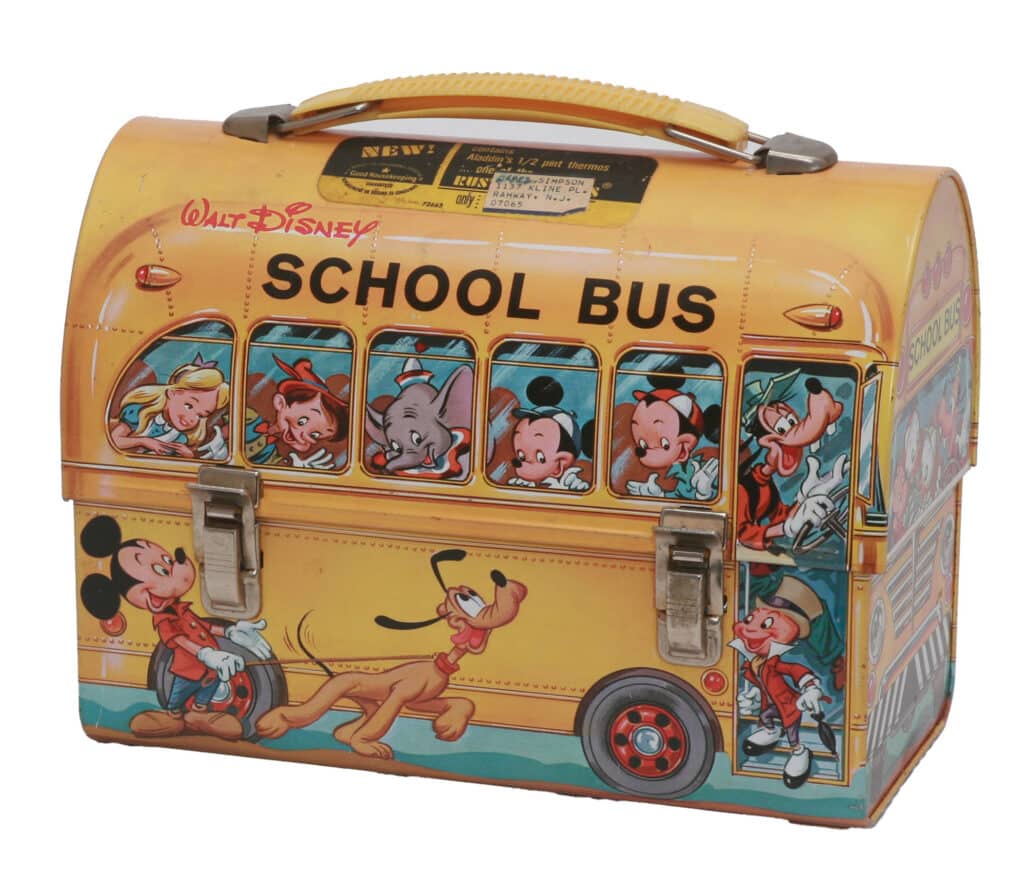
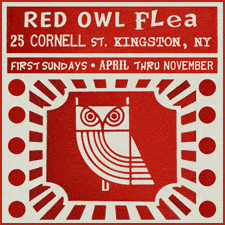
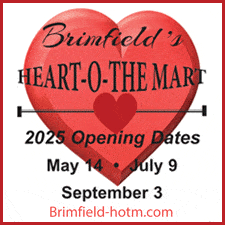


Related posts: